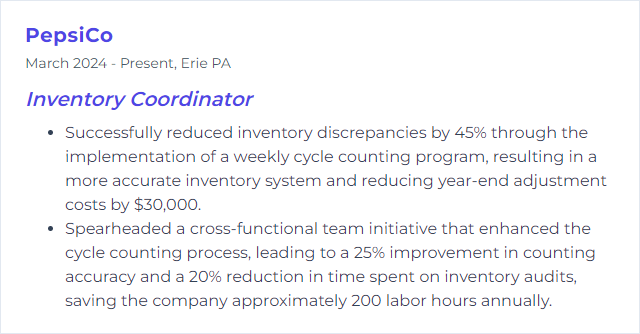Top 12 Inventory Coordinator Skills to Put on Your Resume
An effective inventory coordinator keeps the whole operation humming—stock in the right place, at the right time, with minimal waste. Putting the right skills on your resume signals you can balance accuracy with speed, strategy with execution, and turn messy data into sharp decisions.
Inventory Coordinator Skills
- SAP
- Oracle
- Excel
- QuickBooks
- Forecasting
- RFID
- Barcoding
- ERP (Enterprise Resource Planning)
- WMS (Warehouse Management System)
- JIT (Just-In-Time)
- Inventory Analysis
- Cycle Counting
1. SAP
SAP is a widely used enterprise resource planning platform that ties together purchasing, inventory, finance, and more. For inventory coordinators, it centralizes stock movements, purchasing, and reporting—clean, consistent, and fast.
Why It's Important
SAP provides real-time visibility into stock levels, open orders, and movements. With fewer manual touches and tighter data integrity, decisions get sharper and waste drops.
How to Improve SAP Skills
- Learn the core inventory transactions and master data (materials, vendors, plants, storage locations). Precision here prevents downstream chaos.
- Tighten data hygiene: standard naming, accurate units of measure, consistent cycle counts, and disciplined posting practices.
- Automate where it counts: MRP parameters, reorder points, safety stock, and scheduling agreements tuned to actual demand.
- Build meaningful reports and dashboards using standard analytics; customize only when gaps remain.
- Map processes end-to-end with stakeholders. Remove duplicate steps, reduce manual entries, and document changes.
- Stay current on new features and practice in a sandbox before rollout.
How to Display SAP Skills on Your Resume

2. Oracle
Oracle’s applications support inventory, procurement, orders, and analytics under one umbrella. It’s built for scale and traceability across sites and channels.
Why It's Important
It connects demand, supply, and fulfillment with auditable detail, helping reduce carrying costs while protecting service levels.
How to Improve Oracle Skills
- Standardize item and supplier master data, units, lead times, and costing methods. Clean inputs, reliable outputs.
- Use system-driven replenishment and min/max policies aligned to demand variability and supplier performance.
- Leverage built-in reporting and schedule recurring analyses: turns, days of supply, fill rate, and on-time receipts.
- Enable alerts and approvals for exceptions—backorders, negative on-hands, aging inventory.
- Document playbooks for receiving, adjustments, and returns to minimize posting errors.
- Practice in test environments and share tips in internal knowledge bases.
How to Display Oracle Skills on Your Resume
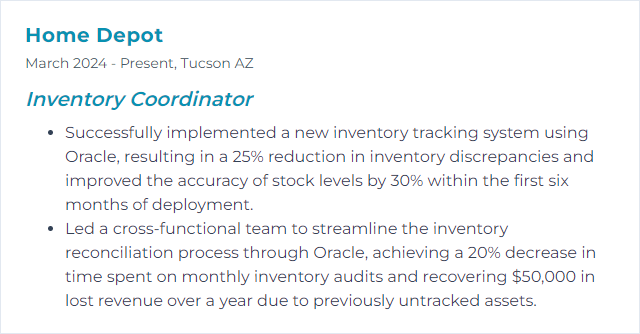
3. Excel
Excel is the scrappy workhorse for ad-hoc analysis, reconciliation, and quick simulations. When systems can’t, spreadsheets jump in.
Why It's Important
It speeds analysis, supports what-if planning, and bridges gaps between systems without waiting for a project queue.
How to Improve Excel Skills
- Organize data with tables, clean headers, and consistent data types. Structured data saves hours.
- Master functions like INDEX/MATCH or XLOOKUP, SUMIFS, COUNTIFS, IF/IFS, TEXT functions, and date math.
- Use PivotTables and slicers to summarize stock movements, turns, shrink, and backlog in seconds.
- Apply data validation, conditional formatting, and error checks to reduce input mistakes.
- Automate repetitive steps with Power Query and simple macros; record first, refine later.
- Adopt keyboard shortcuts and templates for recurring reports.
How to Display Excel Skills on Your Resume

4. QuickBooks
QuickBooks tracks sales, costs, and inventory for small to mid-sized operations, tying items to financials without heavy lift.
Why It's Important
It keeps quantities, average cost, and COGS aligned so purchasing and accounting tell the same story.
How to Improve QuickBooks Skills
- Turn on advanced inventory features (multiple locations, serial/lot tracking) if available in your edition.
- Use barcode scanning where supported to reduce manual entry errors and speed receiving/picking.
- Create custom fields for attributes like reorder points, lead times, and preferred vendor.
- Schedule routine item reconciliations: match purchase orders, receipts, and bills; resolve variances quickly.
- Standardize item naming, units, and categories; archive discontinued SKUs to reduce clutter.
- Build memorized reports for low-stock, slow movers, valuation by location, and open PO status.
How to Display QuickBooks Skills on Your Resume

5. Forecasting
Forecasting turns history and signals into a forward view of demand. Not crystal-ball perfect—good enough to plan with confidence.
Why It's Important
Better forecasts cut stockouts and excess. Cash freed, customers happy, operations calmer.
How to Improve Forecasting Skills
- Segment demand: stable vs. seasonal vs. intermittent. One-size methods mislead.
- Blend methods: moving averages, exponential smoothing, and seasonality factors. Compare error metrics, pick what wins.
- Layer in reality: promotions, product launches, supply constraints, and known events.
- Collaborate with sales, marketing, and suppliers. Shared context trims surprises.
- Track accuracy (MAPE, bias). Review misses monthly and tune parameters.
- Use rolling horizons and scenario planning to stress-test capacity and inventory.
How to Display Forecasting Skills on Your Resume
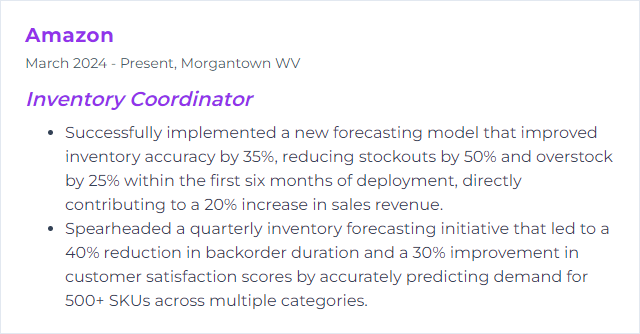
6. RFID
RFID tags and readers identify items wirelessly, even without line of sight. Faster scans, richer data, fewer bottlenecks.
Why It's Important
It delivers real-time inventory intelligence with less manual effort, tightening accuracy from dock to shelf.
How to Improve RFID Skills
- Select the right tags and readers for your materials, packaging, and environment. Metal and liquids need special attention.
- Map read zones and test thoroughly to eliminate dead spots and stray reads.
- Integrate with WMS/ERP so movements post automatically; reduce duplicate entry.
- Establish device maintenance, firmware updates, and spare equipment plans.
- Train teams on tagging standards, placement, and exception handling.
- Harden security: user access controls, encrypted networks, and audit trails.
How to Display RFID Skills on Your Resume
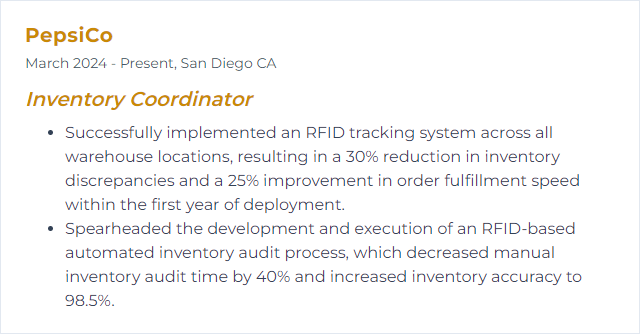
7. Barcoding
Barcodes turn item data into scannable symbols. Simple, cheap, wildly effective when designed and maintained well.
Why It's Important
Scanning slashes errors, speeds transactions, and creates a trustworthy trail from receiving through shipping.
How to Improve Barcoding Skills
- Standardize symbologies and label formats. Keep print quality high and placement consistent.
- Upgrade scanners for your environment—distance, lighting, and durability matter.
- Validate labels before rollout; spot-check regularly to catch wear and misprints.
- Embed barcodes in every key step: receiving, put-away, picking, packing, and adjustments.
- Train on correct scan workflows and common error recovery steps.
- Continuously review scan failure rates and fix root causes fast.
How to Display Barcoding Skills on Your Resume

8. ERP (Enterprise Resource Planning)
ERP systems knit together purchasing, inventory, orders, finance, and reporting. One source of truth beats scattered spreadsheets and siloed apps.
Why It's Important
It enables accurate, real-time visibility across the supply chain, helping balance stock, cash, and service without guesswork.
How to Improve ERP (Enterprise Resource Planning) Skills
- Clean master data and keep it clean. Governance is not glamorous, but it’s gold.
- Integrate adjacent systems (CRM, e-commerce, WMS) to cut rekeying and timing gaps.
- Train users with clear SOPs and quick-reference guides; reinforce with refreshers.
- Customize only where value beats complexity. Prefer configuration over code.
- Exploit planning tools: safety stock policies, lead times, allocation rules, and ATP.
- Measure and iterate: order accuracy, days of supply, turns, and aging inventory.
- Maintain a feedback loop so frontline issues become system enhancements.
How to Display ERP (Enterprise Resource Planning) Skills on Your Resume
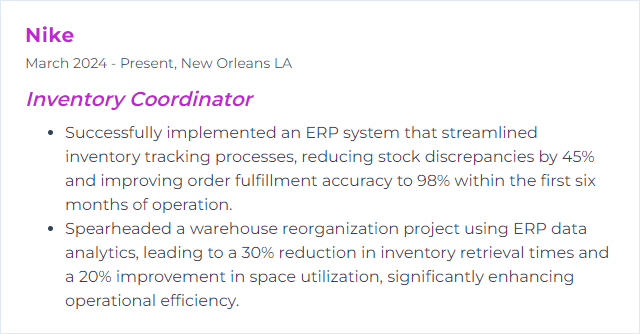
9. WMS (Warehouse Management System)
A WMS directs warehouse work—receiving, put-away, picking, packing, counting. It’s the floor’s brain and stopwatch.
Why It's Important
It improves accuracy, throughput, and space use while exposing bottlenecks you can actually fix.
How to Improve WMS (Warehouse Management System) Skills
- Digitize every movement with barcodes or RFID. Real-time transactions, real results.
- Map optimal slotting: velocity-based placement, ergonomic picks, minimal travel.
- Keep software updated and test changes in a staging environment before go-live.
- Integrate with ERP and carriers for seamless order flow and tracking.
- Use labor and wave planning to balance workloads and cut congestion.
- Track KPIs: pick accuracy, lines per hour, dock-to-stock time, and return handling time.
- Collect feedback from operators; small tweaks often unlock big gains.
How to Display WMS (Warehouse Management System) Skills on Your Resume
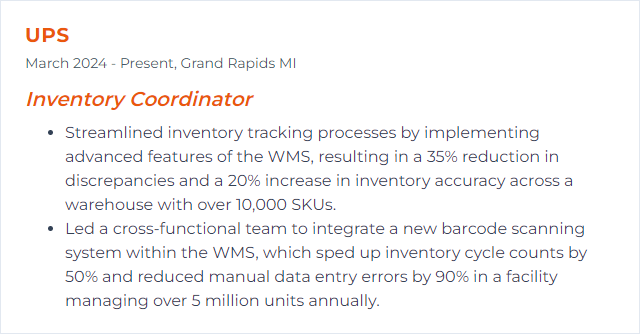
10. JIT (Just-In-Time)
JIT shrinks inventory by timing receipts to actual need. Less sitting on shelves, more flow.
Why It's Important
It trims carrying costs and space while sharpening responsiveness—when the supply base can keep pace.
How to Improve JIT (Just-In-Time) Skills
- Strengthen supplier relationships and cadence: shared forecasts, stable schedules, clear SLAs.
- Improve demand signals and reduce variability with better forecasting and order smoothing.
- Shorten internal lead times: faster receiving, prioritized put-away, streamlined approvals.
- Increase visibility with real-time inventory, ASN usage, and transport tracking.
- Adopt lean practices to remove waste between steps and cut changeover times.
- Build contingency plans: alternates, safety stock for critical items, and escalation paths.
How to Display JIT (Just-In-Time) Skills on Your Resume

11. Inventory Analysis
Inventory analysis probes levels, turns, mix, and trends to decide what to buy, when, and how much. Numbers with purpose.
Why It's Important
It reduces dead stock, prevents stockouts, and aligns working capital with actual demand patterns.
How to Improve Inventory Analysis Skills
- Run ABC/XYZ segmentation to focus rigor where impact is highest.
- Establish a monthly cadence: turns, days of supply, fill rates, shrink, and obsolescence.
- Audit routinely. Reconcile physical counts with system records and fix root causes.
- Set policy by segment: service targets, safety stock, reorder methods, and review frequency.
- Visualize trends with dashboards; spotlight exceptions, not noise.
- Tighten supplier terms: lead times, MOQs, and reliability metrics drive inventory posture.
- Retire or liquidate slow movers with data-backed action plans.
How to Display Inventory Analysis Skills on Your Resume

12. Cycle Counting
Cycle counting checks inventory in small, frequent bites instead of a disruptive annual shutdown. Accuracy stays alive, not once-a-year lucky.
Why It's Important
It keeps records trustworthy, speeds reconciliation, and exposes process issues before they snowball.
How to Improve Cycle Counting Skills
- Use ABC priority: count A items most often, B items regularly, C items on a longer interval.
- Separate counters from handlers to reduce bias; lock transactions during counts.
- Scan every move. Barcodes or RFID tighten traceability and reduce adjustments.
- Investigate variances, don’t just post them. Fix causes: labeling, location errors, unit conversions.
- Schedule counts into daily operations so they happen rain or shine.
- Publish accuracy metrics per area and celebrate improvements.
How to Display Cycle Counting Skills on Your Resume
